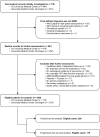Treatment outcome of patients with recurrent glioblastoma multiforme: a retrospective multicenter analysis
- PMID: 28730289
- PMCID: PMC5658463
- DOI: 10.1007/s11060-017-2564-z
Treatment outcome of patients with recurrent glioblastoma multiforme: a retrospective multicenter analysis
Abstract
Glioblastoma multiforme (GBM) universally recurs with dismal prognosis. We evaluated the efficacy of standard treatment strategies for patients with recurrent GBM (rGBM). From two centers in the Netherlands, 299 patients with rGBM after first-line treatment, diagnosed between 2005 and 2014, were retrospectively evaluated. Four different treatment strategies were defined: systemic treatment (SYST), re-irradiation (RT), re-resection followed by adjuvant treatment (SURG) and best supportive care (BSC). Median OS for all patients was 6.5 months, and median PFS (excluding patients receiving BSC) was 5.5 months. Older age, multifocal lesions and steroid use were significantly associated with a shorter survival. After correction for confounders, patients receiving SYST (34.8%) and SURG (18.7%) had a significantly longer survival than patients receiving BSC (39.5%), 7.3 and 11.0 versus 3.1 months, respectively [HR 0.46 (p < 0.001) and 0.36 (p < 0.001)]. Median survival for patients receiving RT (7.0%) was 9.2 months, but this was not significantly different from patients receiving BSC (p = 0.068). Patients receiving SURG compared to SYST had a longer PFS (9.0 vs. 4.3 months, respectively; p < 0.001), but no difference in OS was observed. After adjustments for confounders, patients with rGBM selected for treatment with SURG or SYST do survive significantly longer than patients who are selected for BSC based on clinical parameters. The value of reoperation versus systemic treatment strategies needs further investigation.
Keywords: Recurrent glioblastoma multiforme; Survival outcome; Treatment effectiveness; Treatment strategies.
Figures
References
-
- Stupp R, Hegi ME, Mason WP, et al. Effects of radiotherapy with concomitant and adjuvant temozolomide versus radiotherapy alone on survival in glioblastoma in a randomised phase III study: 5-year analysis of the EORTC-NCIC trial. Lancet Oncol. 2009;10:459–466. doi: 10.1016/S1470-2045(09)70025-7. - DOI - PubMed
Publication types
MeSH terms
LinkOut - more resources
Full Text Sources
Other Literature Sources
Medical



